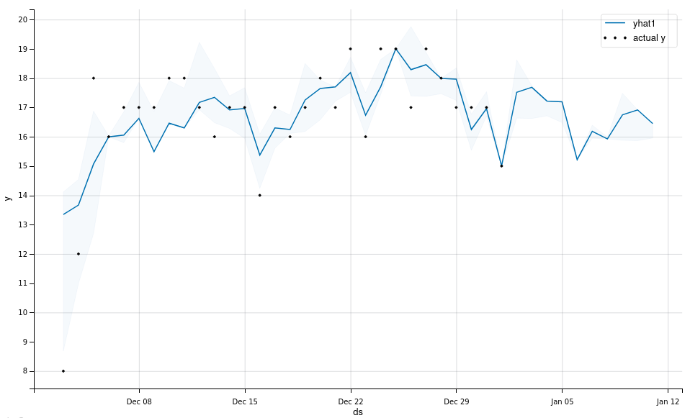Forecasting with Regressors
In the context of forecasting, regressors (also known as predictors or independent variables) are external factors that influence the variable being forecasted. These can include economic indicators, seasonal trends, marketing activities and other relevant data points that help improve the accuracy of demand forecasts.
The importance of Regressors
Incorporating regressors into forecasting models enhances the precision of predictions by accounting for factors that directly or indirectly affect demand. Here are some reasons why regressors are crucial:
Improved Accuracy
By considering a range of influencing factors, forecasts become more reliable and reflective of real-world conditions. Businesses that effectively use regressors in their forecasting models can gain a competitive edge by better anticipating market trends and customer needs.
Understanding Demand Drivers
Regressors help identify and understand the key drivers of demand, providing valuable insights for decision-making. By understanding the factors driving demand, businesses can take proactive measures to manage demand more effectively.
Enhanced Responsiveness
With more accurate forecasts, businesses can respond more effectively to demand fluctuations, ensuring better inventory management and customer satisfaction. They help maintain optimal inventory levels, reducing the risk of overstock or stock-outs.
Better Strategic Planning
Incorporating regressors allows for more informed strategic planning, helping businesses anticipate market changes and adjust their strategies accordingly. Insights gained provide valuable information for strategic decisions, from marketing campaigns to supply chain adjustments.
Regressors in demand forecasting
Demand forecasting involves predicting future customer demand for a product or service. To create effective demand forecasting models, various types of data are used as regressors. The relevance of these parameters depends on the nature of the product being analyzed.
Here is a list of common types of data used as regressors in demand forecasting:
Historical Sales Data
Past sales figures, time series data of sales
Economic Indicators
GDP, inflation rates, unemployment rates, consumer confidence tax
Marketing and Promotion Data
Advertising expenditure, marketing campaigns, promotions and discounts
Product-Specific Data
Product features and specifications, product life cycle stage
Time Factors
Day of the week, month of the year, seasonality, holidays and special events
Pricing Data
Historical prices, discounts and promotions, competitor pricing
Weather Data
Temperature, precipitation, extreme weather events
Demographic Data
Population size, age distribution, income levels, urban vs. rural population
Historical Sales Data
Past sales figures, time series data of sales
Economic Indicators
GDP, inflation rates, unemployment rates, consumer confidence tax
Marketing and Promotion Data
Advertising expenditure, marketing campaigns, promotions and discounts
Product-Specific Data
Product features and specifications, product life cycle stage
Time Factors
Day of the week, month of the year, seasonality, holidays and special events
Pricing Data
Historical prices, discounts and promotions, competitor pricing
Weather Data
Temperature, precipitation, extreme weather events
Demographic Data
Population size, age distribution, income levels, urban vs. rural population
Incorporating regressors into forecasting models is essential for achieving accurate and reliable demand predictions. By considering a range of external factors that influence demand, businesses can enhance their forecasting accuracy, improve inventory management, and make more informed strategic decisions. In a demand-driven environment, the ability to anticipate and respond to market changes is crucial for maintaining competitiveness and customer satisfaction.
Regressors in ForgeFlow's Business Games
In ForgeFlow's Business Games users can step into the role of a CEO and experience the challenges and complexities of running a successful company with Odoo as the underlying Business Management Software. As the CEO, their strategic decision-making skills will be put to the test as they navigate various areas of business operations, sales, purchasing, supply chain, and financial management. In addition, forecasts are used to help users establish their strategies to increase demand and reach profitability. Here's how:
Parameters as regressors
In the Business Game, users can configure various parameters that influence the demand for their final products, such as product prices and daily marketing investment amounts, and plan these values for the future. These parameters are used as regressors for the automated forecasts.
Reactive forecasts
The automated forecasts utilize the configured parameters as regressors, ensuring that predicted future demand responds to these values.
For example, lowering a product's price will lead to an increase in demand, while a decrease in marketing investment will result in reduced demand.
Unified view
To enhance the user experience, all parameters, along with real and forecasted demands, are displayed on a comprehensive dashboard. Users can filter this information by product or measurement type, allowing them to quickly understand how their future configurations will impact the progress of the company.

Business Games are a great way to discover the Odoo Business Management Software and learn how forecasts can effectively help your company improve its results. If you desire to get access, visit the Business Games page.
Explore our related articles

Introduction to forecasting
Accurate forecasting helps maintain optimal inventory levels, reduces costs, improves customer satisfaction, and aids in strategic planning. Learn about its foundations and the possibilities it offers.

Protecting service levels with forecasts
Forecasts provide essential data for operating in today’s volatile
environments by offering valuable insights into future events. Discover
how to effectively protect your service levels with them.

Improve supply reliability with the Supplier Disruption Report
This report evaluates supplier reliability by analyzing the time stock levels spend in critical buffer zones. Learn to identify unreliable suppliers and take corrective actions to maintain a steady flow of materials.
If you are willing to learn more, register to our 1-hour DDMRP Basic Training webinars. Send us a message and our team will contact you with the available sessions:

